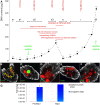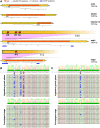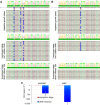A permissive chromatin structure is adopted prior to site-specific DNA demethylation of developmentally expressed genes involved in macronuclear differentiation
- PMID: 23497475
- PMCID: PMC3608066
- DOI: 10.1186/1756-8935-6-5
A permissive chromatin structure is adopted prior to site-specific DNA demethylation of developmentally expressed genes involved in macronuclear differentiation
Abstract
Background: DNA methylation and demethylation are important epigenetic regulatory mechanisms in eukaryotic cells and, so far, only partially understood. We exploit the minimalistic biological ciliate system to understand the crosstalk between DNA modification and chromatin structure. In the macronucleus of these cells, the DNA is fragmented into individual short DNA molecules, each representing a functional expression and replication unit. Therefore, long range epigenomic interaction can be excluded in this system.
Results: In the stichotrichous ciliate Stylonychia lemnae, cytosine methylation occurs in a small subset of macronuclear nanochromosomes expressed only during sexual reproduction. Methylation pattern shows similarity to that observed in fungi and Drosophila. Cytosine methylation correlates with gene activity and chromatin structure. Upon gene activation, cytosines become demethylated and a redistribution of histone post-translational modifications (PTMs) takes place. Evidence is presented that the formation of a permissive chromatin structure in the vicinity of the 5meCs precedes cytosine methylation and is probably a necessary prerequisite for their demethylation. Shortly after demethylation of cytosines occurs, the parental macronucleus degenerates, a new macronucleus is formed from a micronuclear derivative and the specific methylation pattern is transmitted from the germline micronucleus to the new macronucleus.
Conclusions: We show that very few, or even only one, discrete methylated cytosines are required to assign regulatory functions at a specific locus. Furthermore, evidence is provided that a permissive chromatin structure is probably a necessary prerequisite for the demethylation of specific cytosines. Our results allow us to propose a mechanistic model for the biological function of cytosine methylation in the ciliate cell and its regulation during the cell cycle.
Figures




References
-
- Doi A, Park IH, Wen B, Murakami P, Aryee MJ, Irizarry R, Herb B, Ladd-Acosta C, Rho J, Loewer S. Differential methylation of tissue- and cancer-specific CpG island shores distinguishes human induced pluripotent stem cells, embryonic stem cells and fibroblasts. Nat Genet. 2009;41:1350–1353. doi: 10.1038/ng.471. - DOI - PMC - PubMed
LinkOut - more resources
Full Text Sources
Other Literature Sources
Miscellaneous

